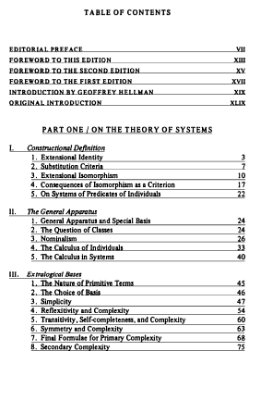Springer, 1966, 355 pp.
Nelson Goodman - american philosopher, bo in Massachusetts, educated at Harvard. Among several academic posts he has held professorships in philosophy at Tufts College and at Brandeis University; in 1968 he was appointed Professor of Philosophy at Harvard. The Structure of Appearance (1951) gained him notice for its penetrating analysis of phenomenalistic systems of philosophy. His reputation increased with the appearance of Fact, Fiction, and Forecast (1954), in which he introduced the celebrated ‘Goodman's paradox’ as a linguistic mode for assessing the validity of philosophical inferences. His contributions to epistemology and the philosophies of science and language have in common his rigorous inductive methods, out of which he develops his valuable theory of projection for differentiating between confirmable and non-confirmable hypotheses; he is regarded as an uncompromising nominalist for his rejection of philosophical categories and his refusal to proceed on the basis of cases other than the particular and individual. Much of his later work has displayed a preoccupation with theories of representation, which he considers with regard to a wide range of instances, including painting, map-making, and musical scores. Among his other publications are Languages of Art (1968), Ways of Worldmaking (1978), and Of Mind and Other Matters (1984)
Nelson Goodman - american philosopher, bo in Massachusetts, educated at Harvard. Among several academic posts he has held professorships in philosophy at Tufts College and at Brandeis University; in 1968 he was appointed Professor of Philosophy at Harvard. The Structure of Appearance (1951) gained him notice for its penetrating analysis of phenomenalistic systems of philosophy. His reputation increased with the appearance of Fact, Fiction, and Forecast (1954), in which he introduced the celebrated ‘Goodman's paradox’ as a linguistic mode for assessing the validity of philosophical inferences. His contributions to epistemology and the philosophies of science and language have in common his rigorous inductive methods, out of which he develops his valuable theory of projection for differentiating between confirmable and non-confirmable hypotheses; he is regarded as an uncompromising nominalist for his rejection of philosophical categories and his refusal to proceed on the basis of cases other than the particular and individual. Much of his later work has displayed a preoccupation with theories of representation, which he considers with regard to a wide range of instances, including painting, map-making, and musical scores. Among his other publications are Languages of Art (1968), Ways of Worldmaking (1978), and Of Mind and Other Matters (1984)

